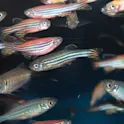
Featured news
16 Aug 2022
Open access publisher Frontiers at ESOF 2022
Frontiers at the EuroScience Open Forum (ESOF) in Leiden

Featured news
16 Aug 2022
Frontiers at the EuroScience Open Forum (ESOF) in Leiden

Featured news
16 Aug 2022
By Peter Rejceck, science writer Image credit: SeventyFour / Shutterstock.com Social isolation can have devastating health effects, especially for elderly people. A number of studies have shown that art is not only good for the soul, but can also improve both physical and mental well-being. Researchers in Canada investigated whether these art-based benefits could be delivered digitally through virtual museum tours. They found that indeed older adults who attended weekly guided tours online felt less frail – offering a public health model to promote healthy aging. Scientists have long known that social isolation is associated with a number of health problems, including increased risks for stroke and heart disease, as well as mental decline and even premature death. The risks are especially acute for older adults, who are more likely to be socially isolated and lonely. The coronavirus pandemic only exacerbated the problem due to the need for social distancing, particularly to protect the health of the world’s elderly population. But the same digital technologies that helped workers connect remotely could help older adults become more physically, mentally and socially healthy when combined with interactive art-based activities. That’s the conclusion from a new study published in the journal Frontiers in […]

Featured news
15 Aug 2022
By Suzanna Burgelman, science writer Image: Paul Abrahams/Shutterstock.com Researchers have found that small mammal communities today are fundamentally different from even a few centuries ago, during North America’s pre-colonial past. They identified small mammal remains from the Anthropocene and archaeological Holocene along a geographical area with varying degrees of human impact and examined diversity across these sites and time periods. Optimistically, the researchers also found that even small, protected spaces can conserve native small mammal communities, highlighting their important role in urban conservation projects. Characterized by rapid climate change, pollution, and landscape alteration, the Anthropocene is an unofficial unit of geological time and is defined as the most recent period in Earth’s history (from the 1950s to present) when human activity started to have a significant impact on the planet’s ecosystems and climate. This impact is increasingly modifying natural ecosystems and threatening biodiversity, for example by quickly expanding urbanization. Researchers at Stanford University have now discovered that modern small mammal communities from the Anthropocene are less diverse and are differently structured then even a few centuries ago, during the Holocene (around 500 years ago), showing the extent of the impacts of human activities on our ecosystems. The results were published […]

Featured news
11 Aug 2022
We speak with the breastfeeding expert Dr Alison Spiro about her career, breastfeeding in a broader cultural and social context and how she hopes to change the way healthcare professionals and society view it.

Featured news
11 Aug 2022
By Colm Gorey and Mischa Dijkstra, Frontiers science writers Image: Shutterstock.com At Frontiers, we bring some of the world’s best research to a global audience. But with tens of thousands of articles published each year, many often fly under the radar. Here are just five amazing papers you may have missed. Researchers challenge idea that human brains shrank 3,000 years ago Last year, an article published to Frontiers in Ecology and Evolution made headlines across the world after it claimed human brains shrank in size approximately 3,000 years ago. This, according to the authors, may have driven by the externalization of knowledge in human societies, thus needing less energy to store a lot of information as individuals. As a result, we developed smaller brains. However, in a recent article, also published to Frontiers in Ecology and Evolution, another team of researchers challenged this notion, questioning several of the original paper’s key hypotheses. Speaking to his university, the University of Nevada, Las Vegas, anthropologist Brian Vilmoare said that “human brain size has not changed in 30,000 years, and probably not in 300,000 years”. In fact, he added, “based on this dataset, we can identify no reduction in brain size in modern […]

Featured news
09 Aug 2022
By K.E.D. Coan, science writer Image: Breck P. Kent/Shutterstock.com Small amounts of highly weathered oil residues from the 2010 Deepwater Horizon disaster were still present in the surroundings ten years later, shows a new report. Crude oil is a complex mixture with many components that undergo chemical reactions in the environment. These transformed chemicals, as well as longer persisting oil products, can impact local ecosystems and a better understanding of the fates of these molecules can help future clean-up efforts. The oil spilled during the Deepwater Horizon disaster in 2010 was largely transformed by the end of that summer, reports a new study in Frontiers in Marine Science. But some small quantities of chemical residues still persisted in the environment even ten years later. This latest study follows the varied fates of the leaked petroleum components, providing important insights for future spills and clean-up efforts. “The better we understand the chemicals and their chemical reactive properties as well as their physical properties, the better we will be able to mitigate oil spills and understand and detect environmental damages from oil spills,” said first author Prof Edward Overton of Louisiana State University. “Our paper describes the most abundant chemicals that make […]

Featured news
05 Aug 2022
By Suzanna Burgelman, Frontiers science writer Image: Zack Frank/Shutterstock.com Researchers have found that California’s forest carbon buffer pool, designed to ensure the durability of the state’s multi-billion-dollar carbon offset program, is severely undercapitalized. The results show that, within the offset program’s first 10 years, estimated carbon losses from wildfires have depleted at least 95% of the contributions set aside to protect against all fire risks over 100 years. This means that the buffer pool is unable to guarantee that credited forest carbon remains out of the atmosphere for at least 100 years. The results, published in Frontiers in Forests and Global Change, illustrate that the program, one of the world’s largest, is likely not meeting its set requirements. Carbon offset programs have become popular action plans to combat the climate crisis. California’s carbon offset program was established to utilize the ability of trees to absorb and store carbon and applies to around 75% of statewide emissions allowances. The program allows forest owners to earn ‘carbon credits’ for preserving trees. Polluters buy credits so that they can emit more CO2 than they’d otherwise be allowed to under state law. Each credit represents one ton of CO2. This exchange is supposed to […]

Featured news
03 Aug 2022
By Colm Gorey, Frontiers science communications manager/Dr Susan Mullally, STScI Image: Dr Susan Mullally, STScI The successful launch of the James Webb Space Telescope earlier this year captivated the world’s attention, promising a revolutionary view deep inside our mysterious universe. One of those involved in the hugely important project was Dr Susan Mullally of the Space Telescope Science Institute who now speaks to Frontiers about the once-in-a-lifetime opportunity. Last month, a new chapter in humanity’s understanding of the cosmos began when the first images taken by the James Webb Space Telescope (JWST) were released to the world. Surpassing the capabilities of the Hubble Space Telescope, JWST will directly observe a part of space and time never seen before and will gaze into the epoch when the very first stars and galaxies formed, more than 13.5bn years ago. Dr Susan Mullally of the Space Telescope Science Institute (STScI) was among those with backstage access to this latest piece of space history, and is currently the deputy project scientist for JWST working to ensure the scientific productivity of the mission. Previously, she worked in the Mikulski Archive for Space Telescopes (MAST) as the lead for archiving the data from NASA’s Transiting Exoplanet […]

Featured news
02 Aug 2022
By Mischa Dijkstra, Frontiers science writer Pair of Gursky’s spectral tarsiers, Tarsius spectrumgurskyae. Image credit: Arie de Gier / Shutterstock.com Researchers show that the notes within duets between female and male Gursky’s spectral tarsiers on Sulawesi are taxing for the singers, presumably due to physiological constraints. An individual’s ‘virtuosity’ in singing these demanding notes could thus signal fitness to conspecifics, similarly to the costly tail of peacocks. Opera arias are typically rich in coloratura, for example fast, high notes that stretch over a wide frequency range. Coloratura aren’t just beautiful to listen to: they are also designed to allow the best singers to show off their virtuosity. Now, researchers from Sam Ratulangi University in Indonesia and Cornell University in the US show that pairs of Gursky’s spectral tarsier sing duets that have evolved to similarly show off virtuosity – at least, for those individuals that manage to pull off their species’ version of coloratura: rapidly repeated broadband notes emitted in coordination to form a duet between adult males and females. The results are published today in Frontiers in Ecology and Evolution. The researchers show that not all tarsiers can sing these duets equally well. Some Gursky’s spectral tarsiers achieve a […]

Featured news
28 Jul 2022
By Cat Bartman / Media Centre, University of East Anglia Eelgrass beds are a form of Blue Carbon Restoring coastal vegetation – so called ‘blue carbon’ habitats – may not be the nature-based climate solution it is claimed to be, according to a new study. In their analysis researchers from the University of East Anglia (UEA), the French Centre National de la Recherche Scientifique (CNRS) and the OACIS initiative of the Prince Albert II of Monaco Foundation, challenge the widely held view that restoring areas such as mangroves, saltmarsh, and seagrass can remove large amounts of carbon dioxide (CO2) from the atmosphere. The findings of their review, published today in the journal Frontiers in Climate, identify seven reasons why carbon accounting for coastal ecosystems is not only extremely challenging but risky. These include the high variability in carbon burial rates, vulnerability to future climate change, and fluxes of methane and nitrous oxide. The authors, who also looked at information on restoration costs, warn that extra measurements can reduce these risks, but would mean much higher costs. However, they stress that blue carbon habitats should still be protected and, where possible, restored, as they have benefits for climate adaptation, coastal protection, […]

Featured news
27 Jul 2022
By Colm Gorey, Frontiers science communications manager Image: Shutterstock.com Each month, Frontiers shines a spotlight on some of the leading research across a wide range of topics. Here are just some of the highlights that resonated strongly with readers on our news site in the month of July. Building blocks for RNA-based life abound at center of our galaxy Nitriles, a class of organic molecules with a cyano group, that is, a carbon atom bound with an unsaturated triple bond to a nitrogen atom, are typically toxic. But paradoxically, they are also a key precursor for molecules essential for life, such as ribonucleotides, composed of the nucleobases or ‘letters’ A, U, C, and G, joined to a ribose and phosphate group, which together make up RNA. Now, a team of researchers from Spain, Japan, Chile, Italy, and the US show in Frontiers in Astronomy and Space Sciences that a wide range of nitriles occurs in interstellar space within the molecular cloud G+0.693-0.027, near the center of the Milky Way. Article link: https://www.frontiersin.org/articles/10.3389/fspas.2022.876870/full 2. Bees’ ‘waggle dance’ may revolutionize how robots talk to each other in disaster zones Where are those flowers and how far away are they? This is the […]

Featured news
27 Jul 2022
We speak with Dr Rachel A. Foster, a Specialty Chief Editor for Aquatic Microbiology in the journals Frontiers in Microbiology and Frontiers in Marine Science, about her career and the challenges faced along the way.

Featured news
21 Jul 2022
By K.E.D. Coan, science writer Thick microbial mats hang under a rock ledge in steam vents that run along the Eastern Rift Zone on Hawaiʻi Island. Image Credit: Jimmy Saw Volcanic habitats in Hawaiʻi are rich in bacterial diversity, including many yet undiscovered species, shows a new study. These lava caves and geothermal vents are similar to what may have once existed on Mars and the bacterial communities that co-exist there provide clues about how life can exist in extreme environments. This work also suggests that there is still much to learn about as-of-yet unknown bacteria here on Earth. The lava caves, lava tubes and geothermal vents on the big island of Hawaiʻi have higher bacterial diversity than scientists expected, reports a new study in Frontiers in Microbiology. These habitats represent how life might have existed on Mars and early Earth in the past, and this study explores the diversity and interactions within these microbial ecosystems. Surprisingly, the results revealed that a group of bacteria called Chloroflexi are often ‘hub’ species, meaning that they are connected with many other species and usually play key ecological roles in the community. Little is known about many Chloroflexi species and further study will […]

Featured news
19 Jul 2022
By Mischa Dijkstra, Frontiers science writer Zebrafish, Danio rerio Scientists identify 54 ‘hotspots’ in the genome for cross-talk between the environment, in particular water temperature, and genes predisposing zebrafish to develop into either sex. There, DNA methylation prompts genetic pathways to change, allowing the influence of temperature to ‘overrule’ the sex-determining genes. As a result, certain born females develop into males. Higher water temperatures induce specific chemical tags at targeted locations on the DNA of embryonic zebrafish. These ‘epigenetic’ changes can then reroute genetic pathways, so that the embryos change sex. This finding, in Frontiers in Cell and Developmental Biology, is not just of fundamental scientific interest. It’s also relevant for conservation, since an influence of temperature on sex determination could be recipe for disaster for species living through rapid climatic change. The study’s first author, Dr Shahrbanou Hosseini, a postdoctoral researcher at the Molecular Livestock Science and Diagnostics Group of the Department of Animal Sciences at Göttingen University, said: “Here we show that epigenetic modifications influence the variation in sex ratio between zebrafish families. This implies that the interaction between genotype and environment in determining sex is mediated by epigenetics.” Genes interact with environment to determine sex From high […]

Featured news
18 Jul 2022
By Colm Gorey, Frontiers science communications manager Image: Shutterstock.com At Frontiers, we bring some of the world’s best research to a global audience. But with tens of thousands of articles published each year, many often fly under the radar. Here are just five amazing papers you may have missed. Impact of Alzheimer’s on the brain may be greater than previously thought A significant review of more than 200,000 scientific publications has shown that the effects of Alzheimer’s disease on the brain are far broader than initially thought. Writing in their review article in Frontiers in Aging Neuroscience, the international team of researchers said that they wanted to understand the breadth and diversity of biological pathways – key molecular chain reactions that drive changes in cells – that contribute to Alzheimer’s disease by research over the last 30 years. They found that while nearly all known pathways have been linked to the disease, the most frequently associated biological mechanisms have not significantly changed in the last three decades, despite major technological advances. These include those related to the immune system, metabolism, and long-term depression. They also found that the top-ranked 30 pathways most frequently referred to in literature remained relatively consistent […]
Get the latest research updates, subscribe to our newsletter